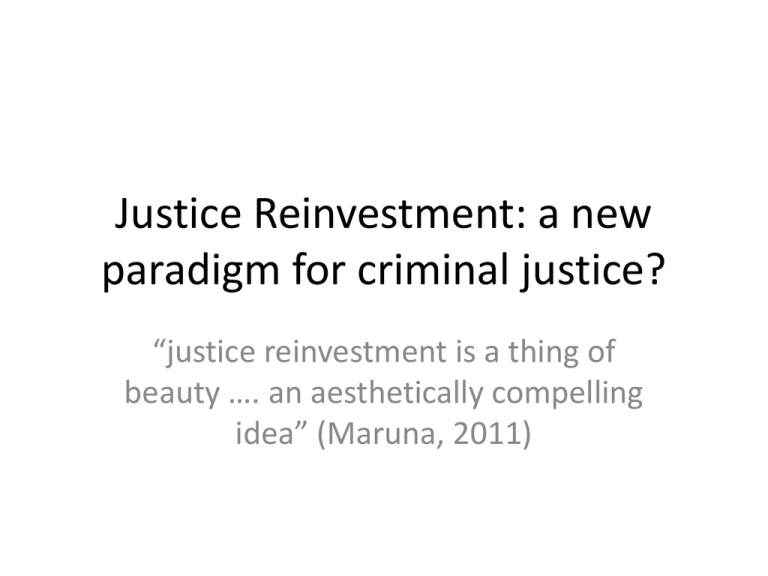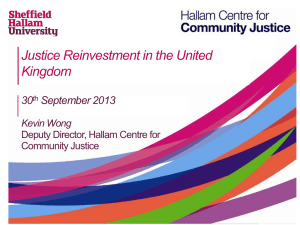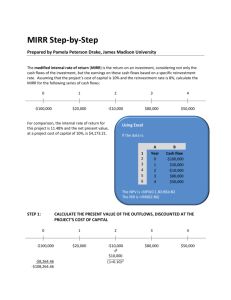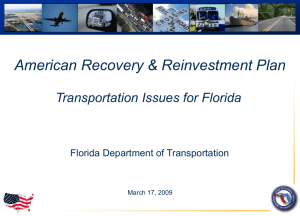Justice Reinvestment: a new paradigm for criminal justice?
advertisement

Justice Reinvestment: a new paradigm for criminal justice? “justice reinvestment is a thing of beauty …. an aesthetically compelling idea” (Maruna, 2011) Prisons or education? • Senator Penny Wright (Greens), 14 March 2012 • http://www.youtube.com/watch?v=mVLynow 8xow A brief history of Justice Reinvestment • 2002-3 Open Society Institute promotes the idea of Justice Reinvestment • Early practice models/methodology developed by state-based agencies (Washington State Institute for Public Policy) and first trial schemes established in 2006-7 • 2009 Michigan plans to redirect $300M in prison funding to community improvement programs. Other “early adopters” include Texas, North Carolina. • 2009 UK House of Commons releases JR policy white paper • 2011 Council of State Governments identifies 17 state jurisdictions with current or planned JR programs • 2012 Australian Senate releases JR report recommending that “the Commonwealth take a leading role in identifying the data required to implement a justice reinvestment approach and establish a national approach to the data collection of justice indicators “ Justice Reinvestment Principles 1. Existing investment models for justice services are a failure 2. Crime and incarceration rates can be reduced by investment in evidence-based treatment and support programs 3. JR requires an integrated approach by government and community based agencies 4. The success of the JR approach can be demonstrated by rigorous evaluation and cost-benefit analysis Justice Reinvestment Principles 1. Existing investment models for justice services are a failure – – – – Increasing expenditure, especially on prison facilities Static or increasing failure rates (recidivism), especially for those released from custody or under a court order Declining public confidence in the system Collateral problems in disadvantaged communities Justice Reinvestment Principles 2. Crime and incarceration rates can be reduced by investment in evidence-based treatment and support programs – – – There are programs that can reliably reduce rates of reoffending (“evidence-based” outcomes) and produce positive cost-benefit outcomes These programs also produce other “social goods” (education, employment, housing, health) Effective implementation requires additional investment of public funds either directly or via the diversion of funds from existing justice programs Justice Reinvestment Principles 3. JR requires an integrated approach by government and community based agencies – – – Effective programs need to be delivered to specific groups within the community (often within defined geographic areas) Community agencies are better prepared and able to deliver these programs Engagement with community agencies also helps to generate the political capital necessary to make JR work Justice Reinvestment Principles 4. The success of the JR approach can be demonstrated by rigorous evaluation and cost-benefit analysis – – – JR program investment needs to be supported by investment in evaluation and CBA Outcomes are reliably measurable and monetary value can be assigned to these outcomes The demonstrated effectiveness of JR projects will build support for more projects JR methods • Washington State Institute for Public Policy methodology 1. ‘Justice mapping’: Analysis of the prison population and of relevant public spending in the communities to which people return from prison. 2. Provision of options to policy makers for the generation of savings and increases in public safety. 3. Implementation of options, quantification of savings and reinvestment in targeted high-risk communities. 4. Measurement of impacts, evaluation and assurance of effective implementation. JR antecedents and variants Punishment Rehabilitation (1960s) Incapacitation Cognitive skills (1980s) “Truth in sentencing” (1980s) Evidence-based interventions Risk/Need/ Responsivity (1990s) Indeterminate detention (2000s) Justice Reinvestment (2010s) JR variants • Payment by Results (PbR): program payments to delivery agencies are contingent on the independent verification of results • Social Impact Bonds: expected public sector savings are used to raise investment for services that improve social outcomes – repayment to investors is contingent upon specified social outcomes being achieved – NSW Social Impact Bond pilot in 2011 – Policy areas included juvenile justice, parenting support for vulnerable families, disability, homelessness and mental health Issues for the NJC • JR requires that the key elements of the “method” (costs, interventions and outcomes) can be isolated at a local level • CJS policy is driven as much by political priorities as it is by evidence-based logic • Current justice funding models already incorporate some of the outcome measurement processes required by the JR approach • Strong outcome evidence typically requires largescale programs











